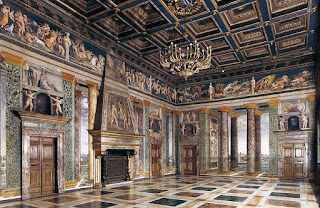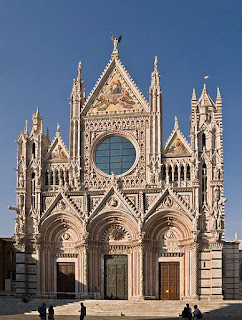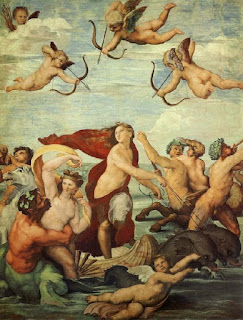Pupil of Bramante who left mark on Rome
 |
| The portrait of Baldassare Peruzzi in Giorgio Vasari's 1568 book Lives of the Most Excellent Painters, Sculptors, and Architects |
Peruzzi worked in his home city and in Rome, where he spent many years as one of the architects of the St Peter’s Basilica project but where he was also responsible for two outstanding buildings in his own right - the Villa Farnesina and the Palazzo Massimo alle Colonne.
The Villa Farnesina, a summer house commissioned by the Sienese banker Agostino Chigi in the Trastevere district, is unusual for its U-shaped floor plan, with a five-bay loggia between the arms.
Raphael and Sebastiano del Piombo were among those who helped decorate the villa with frescoes, but Peruzzi is acknowledged as the chief designer, possibly aided by Giuliano da Sangallo. He was relatively inexperienced at the time but was personally selected by Chigi despite the huge array of talent on offer in the city at the time.
Some of the frescoed paintings on the walls of the interior rooms are also by Peruzzi. One example is the Sala delle Prospettive, in which the walls are painted to create the illusion of standing in an open-air terrace, lined by pillars, looking out over a continuous landscape.
 |
| Peruzzi's brilliant Sala delle Prospettive, with its illusion of an open-air terrace, inside the Villa Farnesina |
The Palazzo Massimo alle Colonne on the present-day Corso Vittorio Emanuele II is still more unusual, featuring a curved facade, dictated by the shape of the foundations of the building that had previously stood on the site - destroyed during the 1527 Sack of Rome by mutinous troops of Holy Roman Emperor Charles V - which had owed their pattern to the semi-circular Odeon of Domitian, an ancient Roman theatre.
Commissioned by Pietro Massimo, descendent of one of the oldest noble families in Rome, the palace has an entrance characterised by a central portico with six Doric columns. Inside, a courtyard and a loggia feature more Doric columns, hence the palace’s name.
 |
| The monument to Peruzzi at the Pantheon |
With the death of Raphael, in 1520 he was appointed as one of the architects engaged on the massive programme to build a new St Peter’s Basilica.
However, he fled Rome following the events of 1527 and returned to Siena, where he was employed as architect to the Republic. He built new fortifications for the city, remodelled the Church of San Domenico and designed a remarkable dam on the Bruna river near Giuncarico.
From 1531 he was back in Rome and again working at St Peter's, where he was appointed the principal architect to the basilica in 1534.
Other works attributed to Peruzzi include a mosaic ceiling for the church of Santa Croce in Gerusalemme, paintings in the churches of Sant'Onofrio and San Pietro in Montorio and in Santa Maria in Portico a Fontegiusta in Siena.
Peruzzi’s son, Giovanni Sallustio, was also an architect. Another son, Onorio, learned painting from his father but then became a Dominican priest in the convent of Santa Maria Sopra Minerva in Rome.
He died in Rome in January 1536, aged 54.
 |
| The Villa Farnesina is one of Baldassare Peruzzi's two masterpieces from his time working in Rome |
The Villa Farnesina can be found on Via della Lungara in the Trastevere district of Rome. After the Farnese family, the villa belonged to the Bourbons of Naples and in 1861 to the Spanish Ambassador in Rome, Bermudez de Castro, Duke of Ripalta. Today, it is owned by the Italian State and accommodates the Accademia dei Lincei, a long-standing academy of sciences. The main rooms of the villa, including the Loggia, are open to visitors from 9am to 2pm on Monday to Saturday, and on every second Sunday of the month from 9am to 5pm. For more details, visit http://www.villafarnesina.it
 |
| The beautiful Romanesque-Gothic cathedral in Siena |
Siena’s Duomo - the Cathedral of St Mary of the Assumption - was designed and completed between 1215 and 1263 on the site of an earlier structure. It has a beautiful façade built in Tuscan Romanesque style using polychrome marble. There had been plans to build an enormous basilica, which would have been the largest in the world, but the idea was abandoned because of lack of funds due to war and the plague. Nonetheless, the cathedral built in its place to plans drawn up by Giovanni di Agostino, with a pulpit designed by Nicola Pisani, is considered a masterpiece of Italian Romanesque-Gothic architecture.
Siena hotels from Booking.com
More reading:
Raphael, the precocious genius who became one of the Renaissance greats
How Agostino Chigi became one of Europe's richest men
The mutinous army that laid waste to Rome
Also on this day:
1274: The death of the philosopher Saint Thomas Aquinas
1678: The birth of Turin architect Filippo Juvarra
1785: The birth of novelist Alessandro Manzoni
Selected books:
Giorgio Vasari's The Lives of the Artists (Oxford World's Classics)
(Picture credits: Peruzzi monument by cmholm;Villa Farnesina by Jean-Pierre Dalbéra; Siena cathedral by Myrabella; all via Wikimedia Commons)
Home
More reading:
Raphael, the precocious genius who became one of the Renaissance greats
How Agostino Chigi became one of Europe's richest men
The mutinous army that laid waste to Rome
Also on this day:
1274: The death of the philosopher Saint Thomas Aquinas
1678: The birth of Turin architect Filippo Juvarra
1785: The birth of novelist Alessandro Manzoni
Selected books:
Giorgio Vasari's The Lives of the Artists (Oxford World's Classics)
(Picture credits: Peruzzi monument by cmholm;Villa Farnesina by Jean-Pierre Dalbéra; Siena cathedral by Myrabella; all via Wikimedia Commons)
Home



